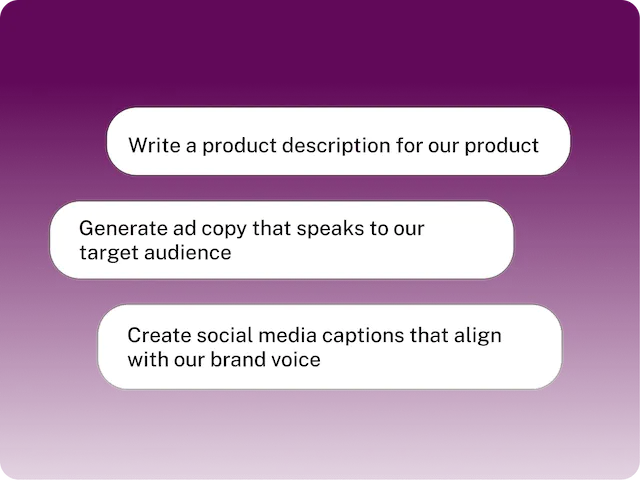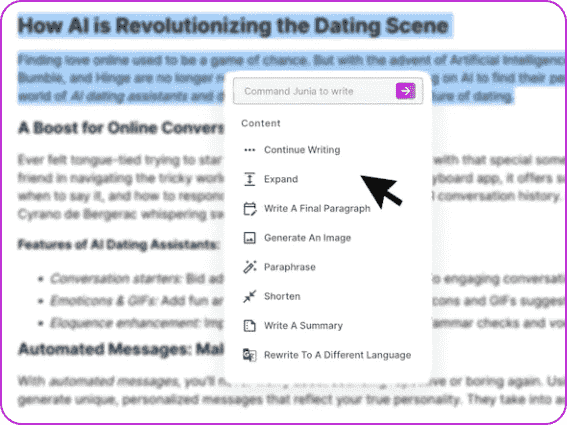How to Add Human Touch to AI-Generated Content Using AI

Introduction
We live in an era where Artificial Intelligence (AI) is rapidly transforming the way we create and consume content. AI-generated content, once a distant dream, is now a reality that's reshaping industries like marketing, journalism, and even scriptwriting! But what exactly is AI-generated content? And why should we care about adding a human touch or as some put it "humanizing AI-generated content" to it?
You see, AI-generated content refers to text, audio, video or any other form of content that's autonomously created by AI algorithms. It’s efficient, scalable and often highly accurate. But there's one thing it typically lacks: a human touch.
As we get into 2025, we find ourselves surrounded by content made by AI everywhere online. To really stand out among this digital flood, adding that unique human element has become more and more important.
So why does the lack of a human touch matter? It matters because humans crave connection. We’re social beings who appreciate genuine interaction - be it with another person or with the words on a screen.
Adding a human touch to AI-generated content allows us to bridge the gap between cold, impersonal algorithms and warm human interaction. It infuses empathy into the binary world of zeros and ones.
Have you ever read an article that made you feel understood? Or watched a video that moved you emotionally? That’s the power of the human touch. It makes the audience feel seen, heard and valued.
Now you might wonder, how to humanize AI generated content? What are the benefits of doing so? Well, there are quite a few:
- Increased Engagement: Humanized content resonates more with readers leading to higher engagement.
- Improved Trust: Content that mirrors human-like qualities builds trust with the audience.
- Enhanced Brand Image: Brands that master the art of adding a human touch to their AI-generated content are often perceived as more empathetic and customer-centric.
- Avoid Penalties from Search Engines: With Google's recent helpful content update, the importance of creating content for humans is now more than ever. Overly robotic, keyword-stuffed content can result in penalties, lower ranking in search results, and massive traffic loss. Humanizing your AI-generated content can help circumvent such repercussions.
- Boosted Sales: It goes without saying that a customer is more likely to purchase from a brand they feel connected to. By humanizing your AI content, you can build this connection and potentially see an increase in conversion rates.
- Inspiring Loyalty: As customers feel heard and valued, they're likely to develop a sense of loyalty towards your brand. This can lead to reduced churn and long-term customer relationships.
Remember when Siri first came out? People loved her not just because she was functional but because she had personality! She joked around, she understood context - in short, she felt human.
That's what we're aiming for when we talk about adding a human touch or humanizing AI-generated content - making our audience feel like they're interacting with a fellow human rather than a machine.
In the following sections, we will:
- Explore how to humanize AI content and precisely achieve this "Siri effect" across various industries using AI itself.
- Debunk common myths that suggest AI cannot generate human-like content.
Let's dive in!
1. Understanding Your Target Audience and Their Pain Points

Unlock an irresistible connection with your audience through AI-generated content, crafted with a laser-focus on your target demographic. Dive deep into their identity, interests, fears, dreams, and roadblocks. Ask yourself: How can your content solve their problems?
For instance, imagine you're writing content specifically for first-time entrepreneurs or startup founders. These individuals often struggle with marketing; they either lack the necessary skills or have no idea where to start. They don't have time for irrelevant details - they're looking for practical advice that delivers real results. To create relevant and humanised AI-generated content, you need to understand their unique challenges:
- Are they short on time?
- Have they tried multiple marketing methods without success, leading to frustration and resignation?
- Have they been misled by poor advice?
Use this insight to guide your AI's content creation. The result will be more relevant and focused articles that meet their specific needs.
To put it into perspective, imagine you're writing a piece comparing alternatives to WriteSonic. To nail it, you must understand why current WriteSonic users face struggles and how other AI writers can fix these issues. Remember: Your audience is at a crossroads—they're trying to choose between two options. It's up to you to provide the in-depth analysis and insights they're desperately seeking.
Or perhaps you're an SEO expert keen to help new startups and solo entrepreneurs drive more traffic to their brand new websites that is currently drawing so little traffic. You'll need to
"Speak their language if you want to connect."
The same rule applies when striving to humanize AI content. The AI tool needs to be programmed to include the audience's particular jargon, familiar phrases, and cultural references in its content creation process to resonate with them.
Here's how to make it happen:
- Inject Industry-Specific Jargon: Make sure the AI tool knows and uses the lingo common in your target audience's industry.
- Utilize Relevant Examples: The inclusion of examples that echo the experiences or goals of your target audience can make the content more relatable and captivating.
- Tweak Tone and Style As Needed: Depending on your target audience's preferences, consider steering your AI tool towards a more formal or casual tone and style.
By speaking the same language as your target audience, you increase the chances of creating content that resonates with them—content that feels as though it's been written by a human, for human, not a machine.
2. Personalized and Contextual AI-Generated Content

Further Understanding Your Audience
Imagine being served an advertisement that not only knows you've been on the hunt for a new laptop, but also recognizes your favored brand and adapts its message to match your preferences. This is what we call personalized AI-generated content. The power of such content lies in its ability to make the audience feel recognized and understood, creating a connection that resonates with them on a deeply personal level.
The key to achieving this level of personalization in AI-generated content lies in feeding our AI models with rich, detailed user data. One such model is Junia, an AI tool that learns your brand voice and generates customized content tailored specifically for your target audience. This involves an understanding of:
- Demographics: Information about the audience's age, location, gender, income level, etc.
- Psychographics: Psychological characteristics including interests, attitudes, values, and lifestyle.
- Past behaviors: Previous interactions with the brand or similar products/services.
- Preferences: Specific likes and dislikes of the audience.
Platforms like Netflix are prime examples of this approach. By considering your viewing history, these platforms use machine learning algorithms to recommend shows you're likely to enjoy. Such data-driven personalization makes the content more relatable and increases engagement.
"The right content + The right people = Engagement"
Staying Relevant
Shifting gears slightly, let's discuss the importance of contextual AI-generated content. Ever come across a piece of content that felt out of place or irrelevant? Such experiences can be jarring for readers and lead to disengagement.
Contextual information allows us to create content that seamlessly fits into the reader's current situation or environment. Understanding the context in which the user interacts with our content — be it their location, time of day, even weather conditions! — can significantly enhance its relevance and impact. For instance:
- A travel app might suggest different activities based on whether it's sunny or rainy at the user's destination.
- An e-commerce platform could promote seasonal items based on current weather conditions.
Junia takes this concept further by analyzing the context you provide about your products or services before generating relevant on-brand messages.
By combining personalized and contextual approaches, we can enhance the human touch in our AI-generated content. This results in content that feels less robotic and more... well... human.
"Personalization + Context = Humanized Content"
Isn't it remarkable how far we've come? From generic computer-generated text to sophisticated AI-created content that understands you—your preferences, your situation—and responds accordingly using an intelligent system like Junia AI Brand Voice. But wait! There's still so much more we can explore to humanize our AI-generated content even further. Let's continue delving deeper!
3. Infusing Personal Opinions and Thoughts in AI-Generated Content

One innovative and exciting approach to lend a human touch to your AI-generated content is by incorporating opinions and imparting instinct-based advice. As unbelievable as it may sound, AI technology has advanced to such an extent that it can accomplish this feat seamlessly, helping you add the missing human touch to AI content!
Let's take an example. Assume you're creating an article on the top digital marketing strategies for 2023. Rather than merely enumerating them in a mundane fashion (yawn), why not make your AI express a preference?
You may wonder how this can be achieved? Well, the process is straightforward:
- Simply input some targeted keywords or thoughts relating to your topic sporadically throughout your AI written content.
- Allow your AI system to seamlessly integrate these thoughts into a cohesive section by simply giving a command: "Hey, piece these texts into one coherent article section."
Advanced tools like Junia AI's Content Editor excel at this task. (Check out the video below for a demonstration.) This intelligent AI Writer discerns patterns, combines your personal insights with pre-existing generated content, and produces an output that is uniquely engaging and empathetic to your reader's needs. Even if you're not a writer or struggle with expressing your thoughts, it's the perfect way to humanize your AI-generated content with human touch and avoid dull outputs.
Let's delve deeper into the essential components of establishing a meaningful connection with your readers through AI content:
- Empathy: Displaying a genuine understanding of your reader's challenges is crucial. For example, if you're constructing an article about time management, demonstrate empathy for those trying to juggle multiple responsibilities within a limited timeframe. This approach makes readers feel acknowledged and valued, thereby fostering a deeper connection.
- Storytelling: Utilizing narrative techniques can make the content more engaging and relatable. Suppose you're writing about overcoming fears; consider integrating a real-life story about someone who vanquished their fear of public speaking by participating in a local Toastmasters club. Adding personal experiences or anecdotes imparts a human touch to AI-generated content.
- Credibility: Trust is a cornerstone in building relationships with your readers. Corroborate your claims with robust data or industry expert quotes to establish credibility. For instance, when discussing the benefits of meditation, cite studies demonstrating its stress-reducing effects or include endorsements from field experts.
- Engagement: Stimulate reader involvement by asking questions or encouraging comments. After sharing tips for adopting healthier eating habits, pose an interactive question like "What healthy recipes do you enjoy? Share them in the comments below." This strategy not only promotes interaction but also helps maintain reader engagement with your content.
While this process might seem daunting, Junia AI's Infobase feature simplifies it significantly. By feeding all these instructions to AI before generating content, the tool can create content tailored to these requirements.
Remember that establishing a connection with readers extends beyond merely writing readable content—it involves creating an unforgettable reading experience that resonates deeply.
Drawing parallels between establishing connections through written text and forming new friendships or relationships in real life might seem apt—it could take some iterations before striking the perfect balance. However, once you achieve this equilibrium, the result will be well worth every effort!
4. Leveraging Legitimate Expertise and Authority

Authenticity is the cornerstone of resonating with your audience, and leveraging legitimate expertise and authority in your content is a powerful way to achieve that. This concept goes beyond merely quoting industry experts or citing studies from recognized institutions—it involves integrating expert insights into your content in a meaningful manner that substantiates the points you're making.
Take for instance, if you're developing content on digital marketing strategies. Rather than just stating facts or sharing tips, consider involving viewpoints or advice from digital marketing gurus or referencing data from reputable marketing research firms. This approach not only bolsters the credibility of your AI-generated content but also reassures readers that the information they are consuming is derived from reliable sources, hence humanizing AI content.
Moreover, integrating expert insights helps add depth and substance to your content written for humans, making it more engaging and valuable for your audience. It's like adding layers of flavor to a dish; each layer enhances the overall taste and leaves a lasting impression.
Demonstrating 'How' in Your Content
Practical value is an unbeatable element when it comes to engaging content. So instead of just telling your audience what to do, show them how to do it right within your content!
For example, if you're writing about SEO techniques, don't just list down the techniques—explain how each one works, why it's effective, and step-by-step instructions on how they can be implemented. You could even include real-life examples or case studies to illustrate these points.
This approach transforms your content from being merely informative to being useful and actionable. It empowers readers by equipping them with the knowledge and skills needed to apply what they've learned—thereby increasing their engagement with your content.
Basing Content on Original Research
Original research is a goldmine for creating unique and humanized AI-generated content. Why? Because it provides exclusive insights that cannot be found anywhere else.
When you base your content on original research—whether it's through conducting surveys, interviews, or analysis of primary data—you offer fresh perspectives that are both enlightening and captivating for your audience.
For instance, say you're crafting a piece on consumer behavior in online shopping. Instead of relying solely on existing reports or articles, conduct your own survey among online shoppers. The findings would be exclusive to you—giving you the upper hand in delivering original insights while adding an extra layer of authenticity and personalization to your content written for humans.
Remember that humanizing AI-generated content does not have a one-size-fits-all solution—it necessitates continuous experimentation with various strategies and methodologies. However, by keeping these principles in mind—analyzing human writing patterns for 'AI speak', incorporating legitimate expertise into your content, demonstrating 'how' within the context of your materials, and basing content on original research—you are well-equipped to create AI-generated content that truly resonates with your audience!
5. Include Screenshots of User-Generated Content (UGC) in Your AI-Generated Articles
.png?token=eyJhbGciOiJIUzI1NiIsInR5cCI6IkpXVCJ9.eyJ1cmwiOiJ1c2VyLWdlbmVyYXRlZC1pbWFnZXMvZjJmOThkNWUtNjNjNC00MTJiLTkyY2QtZjgyNDI5NTE3YWRkL0dyb3VwIDM3NyAoMSkucG5nIiwiaWF0IjoxNjk1MzkzMzc0LCJleHAiOjE4NTMwNzMzNzR9.8f1LvmSEPgw7zszHs9Ad-N4aUQevCwj0_uSzLmltF-w)
With Google's constant algorithm updates to combat AI-written content, you might wonder, "How do you humanize AI content to avoid such penalties?"
In my experience, one of the answers lies with User-Generated Content (UGC). This can take the form of user comments or social media posts screenshots incorporated into your AI-generated articles. Doing so not only enhances authenticity but also bolsters relatability.
Here's how you can effectively accomplish this:
1. Incorporate Screenshots of Topic-Related User Comments or Posts
Note: Always seek permission before using someone else's content in your articles.
Including real-life user experiences and views related to your topic can provide:
- Valuable insights
- Reinforce your points with authentic evidence.
2. Highlight Relevant Social Media Posts
The world of social media is a goldmine for UGC. Consider featuring:
- Positive posts about your brand
- Relevant discussions around your topic
Doing so engages readers further and demonstrate real-world interest and appreciation for your brand or subject matter.
Incorporating UGC into your AI-authored pieces humanizes them, adds intrigue, and amplifies credibility. Keep this in mind as you create your next AI article to truly make it stand out.
6. Leveraging Conversational Language in AI-Generated Content
In the world of AI-generated content everywhere in this online crowed space, the incorporation of conversational language, as opposed to formal language, is an essential strategy to standout. This approach not only enhances readability but also fosters a robust connection with your readers.
The surge in AI-generated content on the internet has led to a saturation of similar sounding outputs across numerous platforms. A vast majority of AI writing tools, such as Jasper AI—a tool favored by many content creators—primarily function as wrappers for ChatGPT. As a result, the produced content tends to sound monotonous and indistinguishable from one platform to another.
To set yourself apart from this uniformity, it's crucial to humanize your AI content and make it sound more human-like and personalized. This is where conversational language comes into play.
- Why Conversational Language?
Conversational language mirrors the way people naturally speak, making your content feel more relatable and engaging. It's less rigid than formal language and invites readers into a dialogue rather than presenting them with a lecture.
- Advantages Over Formal Language
Using conversational language helps your content:
- Engage Readers: Conversational prose draws readers in, making them feel like part of a discussion.
- Increase Readability: The simplicity and flow of conversational language enhance readability.
- Foster Connection: This style resonates more with readers at an emotional level.
- Distinguishing Your Content: Your content will stand out more, especially in an internet flooded with generic AI-generated content.
Embracing a conversational style in your AI-generated content helps you stand out in the crowd of generic AI outputs. It imparts a unique voice to your narrative, making it instantly recognizable among your target audience.
Therefore, the strategic use of conversational language to humanize AI content is not just beneficial—it's essential—to distinguish your content written for humans from the rest.
7. Review and Edit the Generated AI Content

In the quest to create an engaging and human-like tone, it is essential to review and edit content generated by AI meticulously. While AI has made significant strides in generating high-quality content, there may still be instances where certain words or phrases do not quite hit the mark.
Identifying Inappropriate or Irrelevant Terms
Pay close attention to words and terms that don't make sense in the context they're used or don't align with the tone you're aiming for. This could involve industry-specific jargon that's misused or generic, overused phrases that reduce the uniqueness of your content.
For instance, AI often uses terms like "Unleash" and "Delve into". While these words aren't inherently wrong, their frequent use can make your content seem less human-like and more robotic. This is why it's important to remember that we are creating content written for humans.
The Importance of a Human Touch
While AI excels at generating bulk content quickly, it still lacks the innate understanding of nuances that humans possess. Therefore, it's crucial to:
- Look out for any inconsistencies in style or tone.
- Watch for overuse of certain words or phrases.
- Ensure the content aligns with your brand voice and messaging.
Remember
"AI-generated content is not a final product; it's a draft that needs refining."
By following these guidelines, you can effectively review and edit AI-generated content, ensuring it not only reads well but also resonates with your target audience. This process will enable you to maintain a consistent brand voice while leveraging the efficiency of AI-powered content creation.
8. Use Feedback Loop in AI Content Generation
The continuous improvement of your AI-generated content is an essential element in making it more human-like and engaging. One highly effective strategy is to establish a feedback loop. This process allows you to consistently refine and train your AI model based on user feedback, enhancing its performance over time.
Incorporating User Feedback
User feedback is a gold mine for improving AI content generation. It provides direct insights into how your audience responds to different aspects of your content, from the overall tone and style to specific language usage. Here's how you can make use of it:
- Experiment with Different Brand Voices: Your brand voice is a reflection of your company's personality and values. Try out different tones and styles, ranging from professional and authoritative to friendly and conversational. Track audience responses to identify which voice resonates most with them.
- Provide Varied Instructions to Your AI Model: Don't limit your AI to only one type of instruction. Explore various directions, such as asking it to write in a question-and-answer format or create a listicle-style article.
- Analyze the Results: Use analytics tools to track key metrics like engagement rates, click-through rates, and time spent on page. These will give you quantifiable data on what's working and what isn't.
Remember that with each step taken towards 'humanizing' your AI-generated content, you're not just making it more appealing for your readers but also significantly improving its overall effectiveness in achieving your content goals.
Tuning Your Approach Based on Feedback
Feedback loops should not be static; they need to evolve based on the insights gained from user reactions. Regularly review your approach, adjusting instructions given to the AI model as needed. This iterative process will help ensure that your content continues to improve and adapt to changing audience preferences and market trends.
Remember: "AI-generated content is not set in stone; it's a dynamic tool that can be fine-tuned for better results." The power lies in leveraging user feedback effectively through a robust feedback loop process.
By implementing these strategies into your content creation process, you'll be well on your way towards crafting AI-generated material that truly resonates with your target audience—content that doesn't just sound human-like but feels personal, relevant, and engaging.
Debunking Misconceptions: AI's Proficiency in Content Generation

The evolution and advancements in the field of Artificial Intelligence have defied numerous misconceptions, especially regarding its capabilities to generate human-like content. The belief that AI cannot generate creative ideas or capture a specific voice and tone is not entirely true.
These common misconceptions often stem from the understanding that AI's capabilities are confined to its training data, resulting in a knowledge cutoff. However, this is not entirely accurate. If adequately instructed and provided with suitable examples of input and output, sophisticated AI tools like Junia AI can surpass these limitations and effectively humanize AI content.
AI's Ability to Generate Creative Ideas
While it's true that AI doesn't possess creativity in the same way humans do, it can mimic the process of idea generation when fed with a diverse range of data sources. This ability allows AI to generate unique and creative ideas that help in humanizing the content it produces.
These data sources can include:
- Comments from social media platforms such as Twitter and Reddit
- Real-time data on the latest human dialogues
- Vernacular trends
- Popular topics from various platforms
This allows the AI to stay updated with contemporary ways people communicate, which often differentiates human-generated content from AI-generated content. It can draw connections between disparate ideas and concepts, thereby providing unique insights and perspectives.
Capturing Specific Voice and Tone
AI can capture a specific voice and tone with remarkable accuracy. By analyzing numerous examples of a particular writing style or tone, AI can learn to replicate it quite effectively. This capability allows for personalized content that resonates with the target audience, further enhancing the human touch in AI-generated content.
Training Capacities of AI
AI has the capacity to be trained for:
- Varying Sentence Length: AI can adjust sentence length, creating a dynamic narrative that keeps the reader interested. Short sentences provide a quick message, while longer ones delve into details, providing rich context.
- Eliminating Repetition: AI identifies repeated content and eliminates these redundancies, enhancing readability and appeal.
- Incorporating Personalized Stories: Leveraging machine learning algorithms and vast databases, AI crafts personalized narratives based on user preferences or pertinent contexts. This helps in humanizing the AI content.
- Creating Detailed Long-Form Content: AI generates in-depth, long-form content that thoroughly explores all aspects of a subject.
How AI writing tools Mimics Human Writing
AI writers, the ones that are specifically trained for writing SEO-optimized content such as Junia AI, can be trained to write with burstiness – an ability to create intensive periods of high activity or productivity – a characteristic often seen in human writers. They can utilize catchy phrases at appropriate moments to grab the reader's attention and facilitate engagement.
Bonus Tip: Harnessing Social Media Comments to Train AI with Unique Writing Styles and Tones
Today's digital landscape is characterized by the vast range of writing styles and tones apparent in social media comments that are often overlooked by content creators. These comments can be a rich source of inspiration for AI, helping it understand and emulate human-like content, thus making it sound more human. Here's how you can leverage this unique resource:
- Understanding Diverse Writing Styles: Social media encompasses an array of platforms, each with its unique user demographic and communication style. From the casual tone of Twitter to the more formal discourse on LinkedIn, feeding these different styles into your AI model helps it grasp the wide spectrum of human communication.
- Embracing Various Tones: The tone varies significantly across different social media comments. Some may be playful or sarcastic, while others might be serious or informative. By exposing your AI tool to such a range, it can learn to adapt its tone based on the context - a crucial aspect of creating engaging content.
- Learning from Real-time Language Evolution: Language is dynamic, and nowhere is this more evident than on social media. New phrases, slang terms, and abbreviations crop up every day. Feeding this ever-evolving language into your AI ensures that its content remains fresh, relevant, and relatable.
"Your AI is only as good as the data it learns from."
By using social media comments as a training ground for your AI, you can ensure that it creates content that truly resonates with your audience - content that sounds like it was written by a human because it learned from humans!
Tips: Simply feed these social media comments into Junia AI's brand voice feature. The AI can then analyze and use those in its content generation.
Say goodbye to generic AI output and embrace humanized AI content that astonishes your audience with its authenticity.
Conclusion
This discussion has delved into the significance of injecting a human touch into AI-generated content, with a particular emphasis on how you can humanize AI-generated content by using exact AI. Let's pause for a moment to reflect on our purpose.
AI, when equipped with the right training and guidance, has the extraordinary capacity to generate appealing, human-like content that captivates audiences both effectively and efficiently.
The objective isn't to supersede human content creators but rather to enhance their abilities and equip them with tools that enable them to craft more engaging, pertinent, and genuine content.
This is about weaving our narratives, emotions, and personal encounters into AI's fabric. It's about ensuring that our content doesn’t merely address people but also speaks on their behalf.
We also explored in-depth the future of AI-generated content enhanced by a human touch. There's no question that technology will persist in its evolution and refinement. But can it ever mimic the complexity of human emotion and cognition?
While it’s undeniable that AI can replicate human writing styles, generate relevant data-driven content, and even weave a coherent narrative - it lacks one quintessential human trait: our capacity to empathize and connect at an emotional level.
That's where your role becomes crucial! By employing the correct tools such as Junia AI and techniques, you can instill your own unique human touch into AI-generated content by using exact AI. And remember, it’s not about endeavoring to make AI more like us; rather it’s about leveraging AI to magnify what makes us inherently human.
